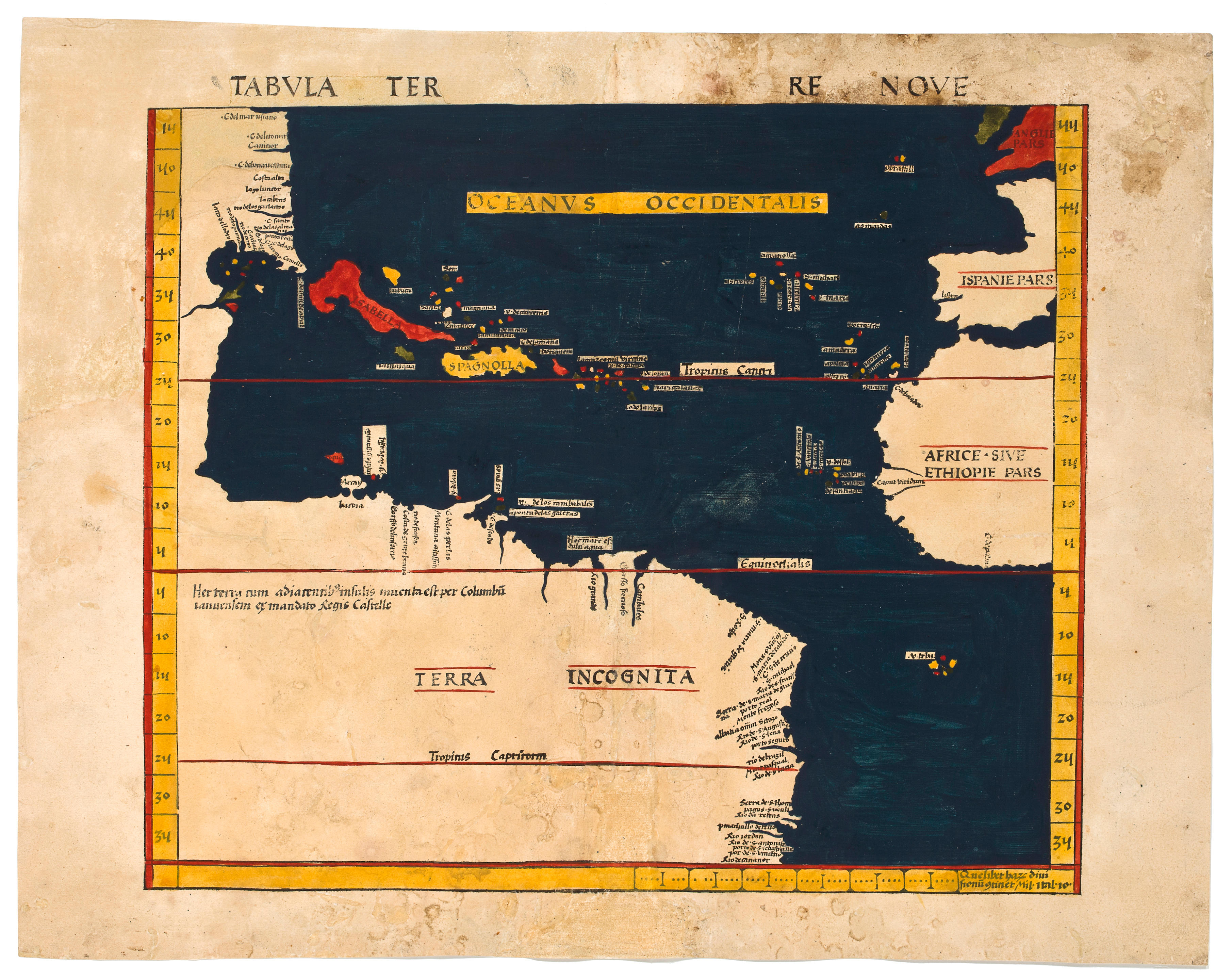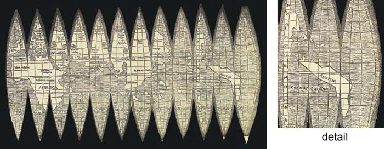WALDSEEMÜLLER, Martin (c.1470 - c.1522). World map in the form of a set of gores for a terrestrial globe. Saint-Dié-des-Vosges: 1507. The first map to name America. The earliest recorded printed globe. The first accurate and complete map of the world in 360 degrees showing a separate Pacific Ocean. The first map to show separate South and North American continents. One of only 5 known copies: a hitherto unknown and unrecorded example. An extreme rarity by ‘the most important cartographer of the early sixteenth century’ (Karrow): the appearance of a previously undiscovered copy of the Waldseemüller gores is a major cartographic event. HISTORICAL CONTEXT In 1505, the cartographer Martin Waldseemüller was invited to join an ecclesiastical college at Saint-Dié-des-Vosges, a small town some 50 miles south-west of Strasbourg. Known as the Gymnasium Vosagense, this group of scholars was under the protection of René II (1451-1508), Duke of Lorraine. Here, Waldseemüller was tasked with creating a new globe, a large world map, and a new edition of Ptolemy’s Geographia . The globe and wallmap came first. Working with his fellow cartographer Matthias Ringmann (1482-1511), Waldseemüller wrote a text, the Cosmographiae Introductio , to explain the new cartography in solidum (globe) and planum (map). A letter written by Waldseemüller to the Basel printer Johann Amerbach on 7 April 1507 announces that the work is in the press at Saint-Dié, and also indicates that the woodblock for the globe had been prepared by this date: The globe (solidum) which I have prepared from Ptolemy is not yet printed, but will be within a month. (Karrow p.570). Cosmographiae Introductio appeared in two editions in Saint-Dié, the first in April 1507 (two issues) and again in August 1507; another edition was published by Waldseemüller alone in 1509 in Strasbourg. It is highly likely that the globe gores were published simultaneously with this text, and it is possible that the present lot could be coeval in date with any of these issues. The genius of Waldseemüller was to break away from standard cartographic conceptions, and to visualise Amerigo Vespucci’s claims that the North and South American continents might be separate from Asia. Audaciously, his globe defines the Pacific long before any European had officially seen it and shows the western coast of South America before any European had sailed along it. Moreover, Waldseemüller placed the name ‘America’ on the New World for the very first time. Only four surviving Western maps earlier than Waldseemüller's depict the Americas in any form. The earliest is the Juan de La Cosa manuscript portolan chart of c.1500 (Museo Naval, Madrid), which celebrates Columbus’ discoveries but covers up its considerable cartographic deficiencies by placing a portrait of Columbus over what should be Central America. The second is the magnificent manuscript Cantino planisphere (Biblioteca Estense, Modena), which can be confidently dated to 1502 when an Italian diplomat, Alberto Cantino, clandestinely had a map made of recent Portuguese discoveries in the north-west Atlantic and smuggled it back to his employer, the Duke of Ferrara. Both of these maps were highly influential in forming cartographic convention, particularly in relation to the Floridian peninsula, the Gulf of Mexico, and the northern coastline of South America; a third manuscript map, the 1504/1505 Caveri (Canerio) portolan chart (Bibliothèque nationale de France, Paris) follows these patterns. There seems little doubt that Waldseemüller was influenced by the Spanish and Portuguese cartography of their new discoveries, as evidenced in these three maps: in the gores. the Gulf of Mexico, Florida, Cuba and other Caribbean islands are quite distinct; the north coast of South America, although crude, follows the earlier prototypes. By contrast, Waldseemüller's gores have little in common with the only earlier printed map to show the Americas: this is the world
WALDSEEMÜLLER, Martin (c.1470 - c.1522). World map in the form of a set of gores for a terrestrial globe. Saint-Dié-des-Vosges: 1507. The first map to name America. The earliest recorded printed globe. The first accurate and complete map of the world in 360 degrees showing a separate Pacific Ocean. The first map to show separate South and North American continents. One of only 5 known copies: a hitherto unknown and unrecorded example. An extreme rarity by ‘the most important cartographer of the early sixteenth century’ (Karrow): the appearance of a previously undiscovered copy of the Waldseemüller gores is a major cartographic event. HISTORICAL CONTEXT In 1505, the cartographer Martin Waldseemüller was invited to join an ecclesiastical college at Saint-Dié-des-Vosges, a small town some 50 miles south-west of Strasbourg. Known as the Gymnasium Vosagense, this group of scholars was under the protection of René II (1451-1508), Duke of Lorraine. Here, Waldseemüller was tasked with creating a new globe, a large world map, and a new edition of Ptolemy’s Geographia . The globe and wallmap came first. Working with his fellow cartographer Matthias Ringmann (1482-1511), Waldseemüller wrote a text, the Cosmographiae Introductio , to explain the new cartography in solidum (globe) and planum (map). A letter written by Waldseemüller to the Basel printer Johann Amerbach on 7 April 1507 announces that the work is in the press at Saint-Dié, and also indicates that the woodblock for the globe had been prepared by this date: The globe (solidum) which I have prepared from Ptolemy is not yet printed, but will be within a month. (Karrow p.570). Cosmographiae Introductio appeared in two editions in Saint-Dié, the first in April 1507 (two issues) and again in August 1507; another edition was published by Waldseemüller alone in 1509 in Strasbourg. It is highly likely that the globe gores were published simultaneously with this text, and it is possible that the present lot could be coeval in date with any of these issues. The genius of Waldseemüller was to break away from standard cartographic conceptions, and to visualise Amerigo Vespucci’s claims that the North and South American continents might be separate from Asia. Audaciously, his globe defines the Pacific long before any European had officially seen it and shows the western coast of South America before any European had sailed along it. Moreover, Waldseemüller placed the name ‘America’ on the New World for the very first time. Only four surviving Western maps earlier than Waldseemüller's depict the Americas in any form. The earliest is the Juan de La Cosa manuscript portolan chart of c.1500 (Museo Naval, Madrid), which celebrates Columbus’ discoveries but covers up its considerable cartographic deficiencies by placing a portrait of Columbus over what should be Central America. The second is the magnificent manuscript Cantino planisphere (Biblioteca Estense, Modena), which can be confidently dated to 1502 when an Italian diplomat, Alberto Cantino, clandestinely had a map made of recent Portuguese discoveries in the north-west Atlantic and smuggled it back to his employer, the Duke of Ferrara. Both of these maps were highly influential in forming cartographic convention, particularly in relation to the Floridian peninsula, the Gulf of Mexico, and the northern coastline of South America; a third manuscript map, the 1504/1505 Caveri (Canerio) portolan chart (Bibliothèque nationale de France, Paris) follows these patterns. There seems little doubt that Waldseemüller was influenced by the Spanish and Portuguese cartography of their new discoveries, as evidenced in these three maps: in the gores. the Gulf of Mexico, Florida, Cuba and other Caribbean islands are quite distinct; the north coast of South America, although crude, follows the earlier prototypes. By contrast, Waldseemüller's gores have little in common with the only earlier printed map to show the Americas: this is the world

.jpg)

.jpg?w=400?width=1600&quality=70)











Try LotSearch and its premium features for 7 days - without any costs!
Be notified automatically about new items in upcoming auctions.
Create an alert